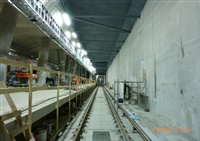Nondestructive Evaluation and Repair of Concrete Retaining Walls at New Subway Station
Total Credits: .5 PDH
- Bundle(s):
- Fall Conference Bundle
- Presenter:
- Nate Rende
- Duration:
- 37 Minutes
- Format:
- Audio and Video
- License:
- Access for 6 month(s) after purchase.
Tags: Conference
Description
Nondestructive testing is often used in conjunction with traditional methods to assess construction, material, or structural deficiencies in new construction. This presentation describes evaluation of unique delamination failures within below-grade, exterior walls of a new subway station. The walls were conventionally reinforced mass concrete cast against a soldier pile and lagging retention system. Shortly after construction, leakage at cracks and joints was observed and injection processes led to delamination of the interior surfaces. The assessment objectives were to determine the extent and cause of near-surface discontinuities and evaluate the structural integrity of the walls. Nondestructive testing included flaw detection using Impulse Response [structural mobility testing] and reinforcement locating using ground-penetrating radar. Sampling and petrographic examinations were conducted to correlate test results with distress conditions and evaluate the in-situ concrete. Analysis of construction records, mix designs, and thermal performance records enabled determination of the cause of the discontinuities. Partial depth repairs were implemented to restore structural capacity.
Presentation Learning Objectives:
- Understand the use of NDE methods for assessment of internal concrete distress
- Understand effective data presentation and reporting of NDE results
- Understand how construction records can be helpful in determining the cause of observed distresses
- Understand the fusion of field assessment, laboratory testing and structural analysis to develop a solution for distress in existing structures
Handouts
| Presentation Slides (2.2 MB) | 14 Pages | Available after Purchase |
Presenter

Nate Rende Related Seminars and Products
Associate III
Wiss, Janney, Elstner Associates, Inc.
Mr. Rende is an Associate Principal with WJE and has managed a broad range of assignments, including structural condition assessment, failure investigation, testing and instrumentation, and repair design. He specializes in applying nondestructive evaluation (NDE) methods to the evaluation of concrete, stone and masonry structures. Mr. Rende is affiliated with several professional societies and has given technical presentations and seminars in nondestructive evaluation throughout the US.
